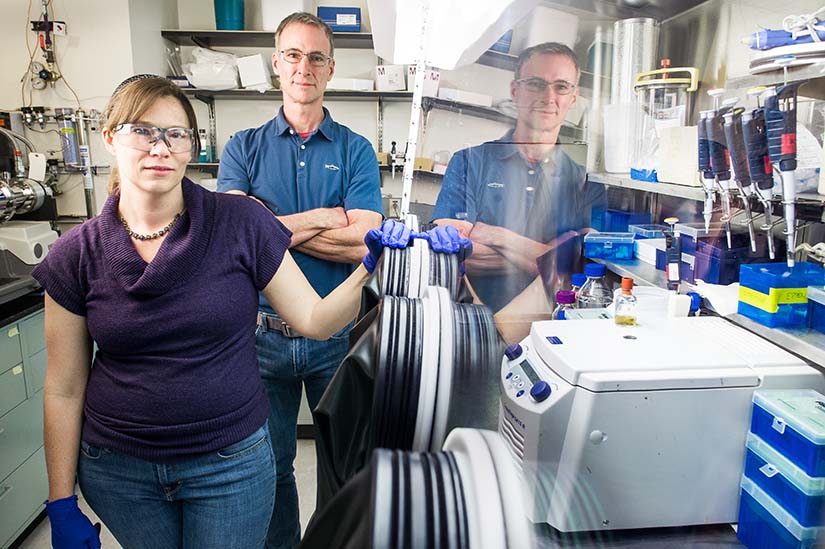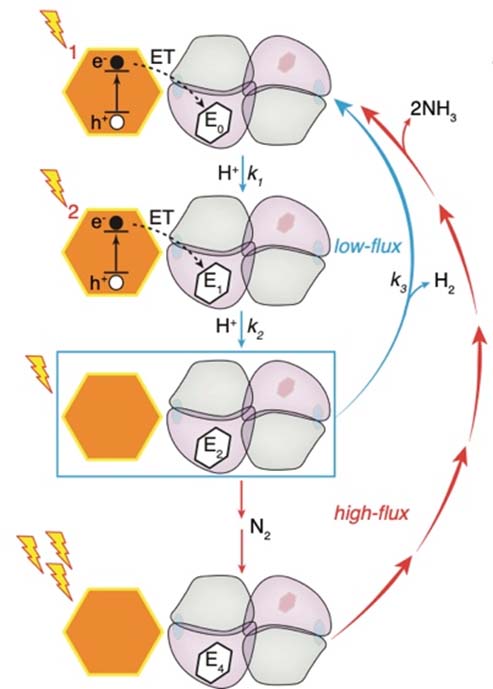Mechanism of Photochemical Nitrogen Reduction
NREL’s mechanism of photochemical nitrogen (N2) reduction research explores nanocrystal–nitrogenase complexes enabling the direct capture of light to energize electron transfer and catalyze the enzymatic reduction of N2 to ammonia.

Main Research Thrusts

Binding Interaction of Molecular Complexes
We seek to understand the binding interactions and molecular arrangements between nanomaterials and nitrogenase, and define the properties of the physical landscape that enable complexes to support functional photoexcited interfacial electron transfer and catalytic reactivity.
Mechanism of Photoexcited Electron Transfer
We explore how the physical properties and excited state photochemistry of nanocrystal materials contribute to the photoexcited electron transfer kinetics to nitrogenase, and how the kinetics influence the quantum efficiencies of catalysis and product formation.
Photochemical Activation of Nitrogenase for N2 Reduction
We seek to define the mechanisms of nitrogenase MoFe protein that support the coupling of light-generated electron flux to intramolecular electron transfer, and catalytic activation and reduction of N2 to ammonia.
Featured Publications
The Kinetics of Electron Transfer From CdS Nanorods to MoFe Protein of Nitrogenase, Journal of Physical Chemistry C (2022)
Tailoring Electron Transfer Pathway for Photocatalytic N2-to-NH3 Reduction in a CdS Quantum Dots-Nitrogenase System, Sustainable Energy & Fuels (2022)
Dissecting Electronic-Structural Transitions in the Nitrogenase MoFe Protein P‑Cluster During Reduction, Journal of the American Chemical Society (2022)
Excitation-Rate Determines Product Stoichiometry in Photochemical Ammonia Production by CdS Quantum Dot-Nitrogenase MoFe Protein Complexes, ACS Catalysis (2020)
Defining Intermediates of Nitrogenase MoFe Protein during N2 Reduction under Photochemical Electron Delivery from CdS Quantum Dots, Journal of the American Chemical Society (2020)
Electron Transfer from Semiconductor Nanocrystals to Redox Enzymes, Annual Review of Physical Chemistry (2020)
Temperature-Dependent Transient Absorption Spectroscopy Elucidates Trapped-Hole Dynamics in CdS and CdSe Nanorods, Journal of Physical Chemistry Letters (2019)
Light-Driven Dinitrogen Reduction Catalyzed by a CdS: Nitrogenase MoFe Protein Biohybrid, Science (2016)
Research Staff
Gordana Dukovic (University of Colorado-Boulder)
John W. Peters (Washington State University)
Lance C. Seefeldt (Utah State University)
Mark Willis (Washington State University)
Bryant Chica
Effie Kisgeropoulos
Hayden Kallas (Utah State University)
Lauren Pellows (University of Colorado-Boulder)
U.S. Department of Energy Support
This work is funded by the U.S. Department of Energy, Office of Science, Office of Basic Energy Sciences, Division of Chemical Sciences, Geosciences, and Biosciences, Solar Photochemistry Program.
Contact
Principal Scientist, Manager of the Physical Biochemistry and Photosynthesis Group
Share
